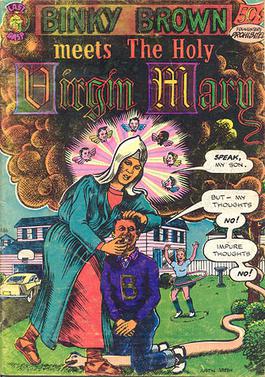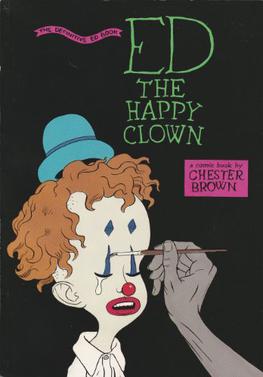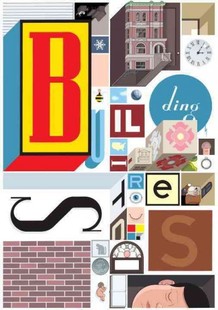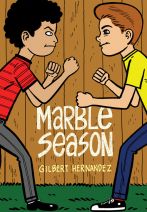
Gilberto Hernández, usually credited as Gilbert Hernandez and also by the nickname Beto, is an American cartoonist. He is best known for his Palomar/Heartbreak Soup stories in Love and Rockets, an alternative comic book he shared with his brothers Jaime and Mario.

Franklin Christenson "Chris" Ware is an American cartoonist known for his Acme Novelty Library series and the graphic novels Jimmy Corrigan, the Smartest Kid on Earth (2000), Building Stories (2012) and Rusty Brown (2019). His works explore themes of social isolation, emotional torment and depression. He tends to use a vivid color palette and realistic, meticulous detail. His lettering and images are often elaborate and sometimes evoke the ragtime era or another early 20th-century American design style.

Binky Brown Meets the Holy Virgin Mary is an autobiographical comic by American cartoonist Justin Green, published in 1972. Green takes the persona of Binky Brown to tell of the "compulsive neurosis" with which he struggled in his youth and which he blamed on his strict Roman Catholic upbringing. Green was later diagnosed with obsessive–compulsive disorder (OCD) and came to see his problems in that light.
An autobiographical comic is an autobiography in the form of comic books or comic strips. The form first became popular in the underground comix movement and has since become more widespread. It is currently most popular in Canadian, American and French comics; all artists listed below are from the U.S. unless otherwise specified.

JaimeHernandez is the co-creator of the alternative comic book Love and Rockets with his brothers Gilbert and Mario.

It's a Good Life, If You Don't Weaken is a graphic novel by Canadian cartoonist Seth. It appeared in a collected volume in 1996 after serialization from 1993 to 1996 in issues #4–9 of Seth's comic book series Palookaville. The mock-autobiographical story tells of its author's obsessive search for the work of a fictional forgotten cartoonist.

The Playboy is a graphic novel by the Canadian cartoonist Chester Brown, serialized in 1990 in Brown's comic book Yummy Fur and collected in different revised book editions in 1992 and 2013. It deals with Brown's guilt and anxiety over his obsessive masturbation to Playboy Playmate models.

I Never Liked You is a graphic novel by Canadian cartoonist Chester Brown. The story first ran between 1991 and 1993 under the title Fuck, in issues #26–30 of Brown's comic book Yummy Fur; published in book form by Drawn & Quarterly in 1994. It deals with the teenage Brown's introversion and difficulty talking to others, especially members of the opposite sex—including his mother. The story has minimal dialogue and is sparsely narrated. The artwork is amongst the simplest in Brown's body of work—some pages consist only of a single small panel.

Ed the Happy Clown is a graphic novel by Canadian cartoonist Chester Brown. Its title character is a large-headed, childlike children's clown who undergoes one horrifying affliction after another. The story is a dark, humorous mix of genres and features scatological humour, sex, body horror, extreme graphic violence, and blasphemous religious imagery. Central to the plot are a man who cannot stop defecating; the head of a miniature, other-dimensional Ronald Reagan attached to the head of Ed's penis; and a female vampire who seeks revenge on her adulterous lover who had murdered her to escape his sins.

The Narrative Corpse is a chain story, or comic jam, created by 69 all-star cartoonists in the early-to-mid 1990s. A graphic novel compilation of the result was published in 1995.
Comics studies is an academic field that focuses on comics and sequential art. Although comics and graphic novels have been generally dismissed as less relevant pop culture texts, scholars in fields such as semiotics, aesthetics, sociology, composition studies and cultural studies are now re-considering comics and graphic novels as complex texts deserving of serious scholarly study.
Canadian cartoonist Chester Brown attracted the attention of critics and peers in the early 1990s alternative comics world when he began publishing autobiographical comics in his comic book Yummy Fur. During this period Brown produced a number of short strips and two graphic novels: The Playboy (1992) and I Never Liked You (1994). The personal and revealing deal with Brown's social awkwardness and introversion, and the artwork and page layouts are minimal and organic. In 2011 Brown returned to autobiography with Paying for It, an account of his experience with prostitutes.

Poison River is a graphic novel by American cartoonist Gilbert Hernandez, published in 1994 after serialization from 1989 to 1993 in the comic book Love and Rockets. The story follows the life of the character Luba from her birth until her arrival in Palomar, the fictional Central American village in which most of Hernandez's stories in Love and Rockets take place.

Building Stories is a 2012 graphic novel by American cartoonist Chris Ware. The unconventional work is made up of fourteen printed works—cloth-bound books, newspapers, broadsheets and flip books—packaged in a boxed set. The work took a decade to complete, and was published by Pantheon Books. The intricate, multilayered stories pivot around an unnamed female protagonist with a missing lower leg. It mainly focuses on her time in a three-story brownstone apartment building in Chicago, but also follows her later in her life as a mother. The parts of the work can be read in any order.
Human Diastrophism, also known as Blood of Palomar, is a graphic novel by American cartoonist Gilbert Hernandez. It appeared in serialized form in the comic book Love and Rockets in 1987–88, and it first appeared in collected form in 1989 in The Complete Love and Rockets, Volume 8: Blood of Palomar. The story tells of a serial killer in the fictional Latin American village of Palomar, and the political and social implications of the insular villagers' growing contact with the outside world.
Julio's Day is a graphic novel by Gilbert Hernandez, serialized in Love and Rockets Volume 2 in 2001–2007 and collected in 2013. It tells the story of a man whose life spans the years 1900 to 2000.

Love and Rockets X is a graphic novel by American cartoonist Gilbert Hernandez. Its serialization ran in the comic book Love and Rockets Vol. 1 #31–39 from 1989 to 1992, and the first collected edition appeared in 1993.
Bumperhead is a graphic novel by American cartoonist Gilbert Hernandez, published by Drawn & Quarterly in 2014.
Sloth is a graphic novel by American cartoonist Gilbert Hernandez, published by Vertigo in 2006. The story opens with the teenaged Miguel Serra awakening from a year-long coma. The surreal tale unravels as its protagonists delve into the legends of the sleepy suburban town they live in. The book is unrelated to Hernandez's Palomar stories and is the first of Henandez's graphic novel not compiled from smaller parts.
The Children of Palomar is a comics compilation by American cartoonist Gilbert Hernandez, published in 2013. It collects five stories originally published in 2006 and 2007 in the three-issue series New Tales of Old Palomar.












